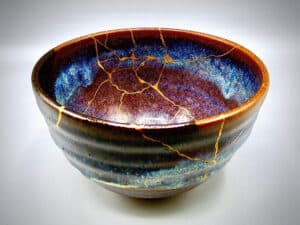
Understanding Imperfection
Kintsugi is the Japanese art of repairing broken pottery by mending the areas of breakage with lacquer mixed with gold, silver, or platinum, giving the resulting piece a unique, beautiful appearance. The philosophy behind kintsugi is that the repair is part of the history of the object and that the cracks and breaks give the object character and beauty.
The concept of kintsugi can be viewed as a metaphor for coping with emotional or psychological trauma. Just as the broken pottery is mended and strengthened through the process of kintsugi, individuals who have experienced trauma can also learn to heal and strengthen themselves through their struggles.
The concept of kintsugi can help us understand that emotional or psychological scars are not something to be hidden or ashamed of but something that can be embraced and celebrated as part of their unique journey. The idea that the cracks and breaks in an object can give it character and beauty can apply to the idea that our struggles can also strengthen us and make us become more resilient.
Wabi-sabi is a Japanese aesthetic concept that values the beauty of things that are imperfect, impermanent, and incomplete. It is the art of finding beauty in things that are “worn,” “weathered,” or “aged.” Wabi-sabi is often associated with Zen Buddhism and has been described as a way of living that emphasizes simplicity, humility, and the appreciation of natural and humble objects. We can learn to accept our own imperfections and impermanence. We can come to realize that these are a natural part of the human experience. This can help us develop a more accepting and compassionate view of ourselves and others, which can be beneficial for mental health and well-being.
Turn your wounds into wisdom
– Oprah Winfrey
